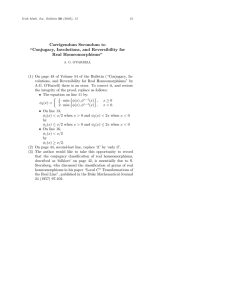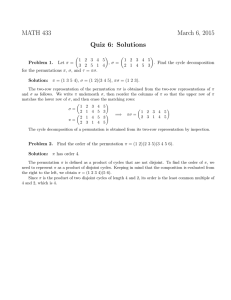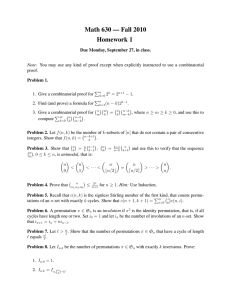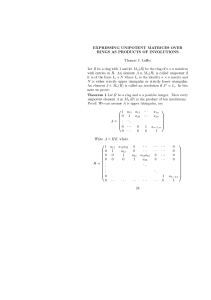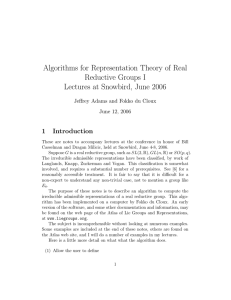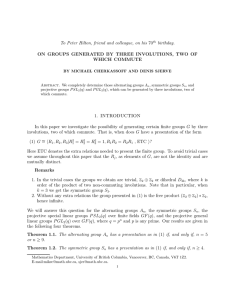Representing Random Permutations as a Product of Two Involutions Charles Burnette
advertisement
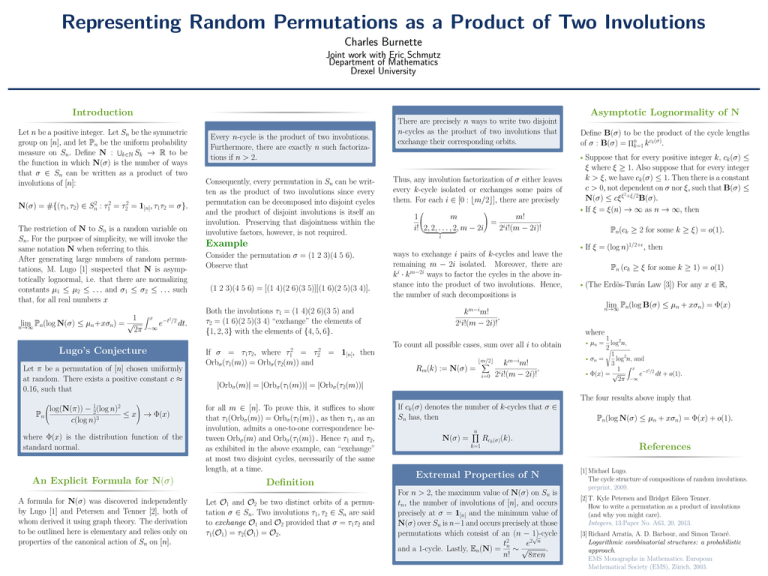
Representing Random Permutations as a Product of Two Involutions
Charles Burnette
Joint work with Eric Schmutz
Department of Mathematics
Drexel University
Introduction
Asymptotic Lognormality of N
Let n be a positive integer. Let Sn be the symmetric
group on [n], and let Pn be the uniform probability
S
measure on Sn. Define N : k∈N Sk → R to be
the function in which N(σ) is the number of ways
that σ ∈ Sn can be written as a product of two
involutions of [n]:
N(σ) = #{(τ1, τ2) ∈
2
Sn
:
2
τ1
=
2
τ2
= 1[n], τ1τ2 = σ}.
The restriction of N to Sn is a random variable on
Sn. For the purpose of simplicity, we will invoke the
same notation N when referring to this.
After generating large numbers of random permutations, M. Lugo [1] suspected that N is asymptotically lognormal, i.e. that there are normalizing
constants µ1 ≤ µ2 ≤ . . . and σ1 ≤ σ2 ≤ . . . such
that, for all real numbers x
1 Z x −t2/2
√
e
dt.
lim
P
(log
N(σ)
≤
µ
+xσ
)
=
n
n
n
n→∞
2π −∞
Lugo’s Conjecture
Let π be a permutation of [n] chosen uniformly
at random. There exists a positive constant c ≈
0.16, such that
Every n-cycle is the product of two involutions.
Furthermore, there are exactly n such factorizations if n > 2.
Consequently, every permutation in Sn can be written as the product of two involutions since every
permutation can be decomposed into disjoint cycles
and the product of disjoint involutions is itself an
involution. Preserving that disjointness within the
involutive factors, however, is not required.
Example
Consider the permutation σ = (1 2 3)(4 5 6).
Observe that
(1 2 3)(4 5 6) = [(1 4)(2 6)(3 5)][(1 6)(2 5)(3 4)].
Both the involutions τ1 = (1 4)(2 6)(3 5) and
τ2 = (1 6)(2 5)(3 4) “exchange” the elements of
{1, 2, 3} with the elements of {4, 5, 6}.
2
τ1
If σ = τ1τ2, where
=
Orbσ (τ1(m)) = Orbσ (τ2(m)) and
2
τ2
There are precisely n ways to write two disjoint
n-cycles as the product of two involutions that
exchange their corresponding orbits.
Define B(σ) to be the product of the cycle lengths
Qn
of σ : B(σ) = k=1 k ck (σ).
• Suppose
Thus, any involution factorization of σ either leaves
every k-cycle isolated or exchanges some pairs of
them. For each i ∈ [0 : bm/2c], there are precisely
m!
1
m
=
ii!(m − 2i)!
i! 2,
2,
.
.
.
,
2
,
m
−
2i
2
|
{z
}
that for every positive integer k, ck (σ) ≤
ξ where ξ ≥ 1. Also suppose that for every integer
k > ξ, we have ck (σ) ≤ 1. Then there is a constant
c > 0, not dependent on σ nor ξ, such that B(σ) ≤
ξ 2+ξ/2
N(σ) ≤ cξ
B(σ).
• If ξ = ξ(n) → ∞ as n → ∞, then
Pn(ck ≥ 2 for some k ≥ ξ) = o(1).
i
ways to exchange i pairs of k-cycles and leave the
remaining m − 2i isolated. Moreover, there are
k i · k m−2i ways to factor the cycles in the above instance into the product of two involutions. Hence,
the number of such decompositions is
• If
ξ = (log n)1/2+, then
Pn (ck ≥ ξ for some k ≥ 1) = o(1)
• (The
Erdös-Turán Law [3]) For any x ∈ R,
lim
P
(log
B(σ)
≤
µ
+
xσ
)
=
Φ(x)
n
n
n
n→∞
k m−im!
.
2ii!(m − 2i)!
where
To count all possible cases, sum over all i to obtain
= 1[n], then
Rm(k) := N(σ) =
bm/2c
X
i=0
m−i
k m!
.
2ii!(m − 2i)!
|Orbσ (m)| = |Orbσ (τ1(m))| = |Orbσ (τ2(m))|
1 2
• µn = log n,
2
s
1 3
• σn =
log n, and
3
Z x
1
−t2/2
• Φ(x) = √
e
dt + o(1).
2π −∞
The four results above imply that
1
2
log(N(π))
−
(log
n)
2
Pn
c(log n)3
≤ x → Φ(x)
where Φ(x) is the distribution function of the
standard normal.
An Explicit Formula for N(σ)
A formula for N(σ) was discovered independently
by Lugo [1] and Petersen and Tenner [2], both of
whom derived it using graph theory. The derivation
to be outlined here is elementary and relies only on
properties of the canonical action of Sn on [n].
for all m ∈ [n]. To prove this, it suffices to show
that τ1(Orbσ (m)) = Orbσ (τ1(m)) , as then τ1, as an
involution, admits a one-to-one correspondence between Orbσ (m) and Orbσ (τ1(m)) . Hence τ1 and τ2,
as exhibited in the above example, can “exchange”
at most two disjoint cycles, necessarily of the same
length, at a time.
Definition
Let O1 and O2 be two distinct orbits of a permutation σ ∈ Sn. Two involutions τ1, τ2 ∈ Sn are said
to exchange O1 and O2 provided that σ = τ1τ2 and
τ1(O1) = τ2(O1) = O2.
If ck (σ) denotes the number of k-cycles that σ ∈
Sn has, then
N(σ) =
n
Y
Rck (σ)(k).
k=1
Extremal Properties of N
For n > 2, the maximum value of N(σ) on Sn is
tn, the number of involutions of [n], and occurs
precisely at σ = 1[n] and the minimum value of
N(σ) over Sn is n−1 and occurs precisely at those
permutations which consist of an (n − 1)-cycle
√
t2n
e2 n
and a 1-cycle. Lastly, En(N) = ∼ √
.
n!
8πen
Pn(log N(σ) ≤ µn + xσn) = Φ(x) + o(1).
References
[1] Michael Lugo.
The cycle structure of compositions of random involutions.
preprint, 2009.
[2] T. Kyle Petersen and Bridget Eileen Tenner.
How to write a permutation as a product of involutions
(and why you might care).
Integers, 13:Paper No. A63, 20, 2013.
[3] Richard Arratia, A. D. Barbour, and Simon Tavaré.
Logarithmic combinatorial structures: a probabilistic
approach.
EMS Monographs in Mathematics. European
Mathematical Society (EMS), Zürich, 2003.


